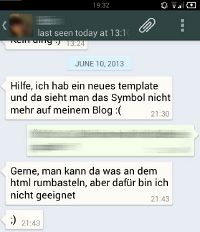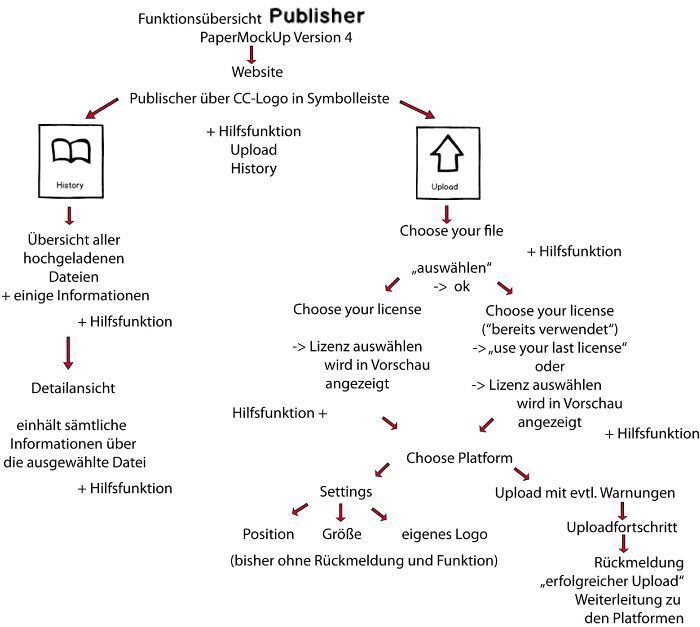User Research
Research we did
During the course Human Centered Design we conducted an exploratory user study to find out about the acquaintance of Creative Commons, potential pitfalls and caveats of its usage. Our probands were selected from students of the Bauhaus University Weimar from courses of studies ranging from Media Arts & Design over Visual Communication to Product Design aged between 20 and 28 years. All of them were selected for their unawareness of local copyright jurisdiction and licensing models (e.g. CC). The short interviews took place in their personal environment during the activity of publishing original content on their personal (micro)blogging platforms. In advance our group defined the basic premise of identifying the users motivation of publishing their works in the web. After each interview we presented the participants with the concept of Creative Commons and introduced them to the website and the function of choosing their own fitting license.
One participant gladly allowed us to publish the complete interview which you can download here: (German language)
(Participant #3, "Emily"):
- Part 1 Media:interview-p3-part1.mp3
- Part 2 Media:interview-p3-part2.mp3
Each interview has then been assessed by our group to identify the following problems, motivations and activities.
Problems we identified
One of the major problems we identified was inherent to our target group selection, which is the unawareness of Creative Commons. Most users did not know the full dimension of the rights they hold of their work and along with these how they restrict the usage of it to interested parties.
After the introction to the Creative Commons licenses and its concept most users were quite interested in using them, but as we found out were struggling how to continue from there. Some participants were not familiar with HTML and had no idea how to tag their content properly with their chosen CC license.
We identified the following Motivations and Goals of users
Before the knowledge of CC the users goals consisted of their wish to publish their project work to their models they worked with, friends and potential clients as an impromptu portfolio.
After the introduction to CC all of them were interested in opening parts of their work to the commons and using a less restrictive license.
We identified the following important acitvities
- Usage of a web browser
- Activity in online communities or social networks and especially (micro)blogging platforms (tumblr, soup.io, facebook, fotocommunity)
- Performing image uploads on said platforms and adding tag information
Our Ideas
The non-bothersome CC educator
What is the essence of this solution?
We propose a software solution which is capable of identifying potential users who would be interested in CC and would benefit from it. This process should intercept at a strategically important point in the workflow of the user, for example right after a finished image upload to a website.
Why are current solutions unable to support users in this?
To address this problem domain usually campaigning through advertisements comes to mind. In contrast, our idea addresses only creative users who already participate in some sort of sharing. Furthermore, we pursue the goal of communicating with the user when his attention is focused on his personal sharing activity.
The license manager
What is the essence of this solution?
A piece of software which eases the access to the Creative Commons license generator with the capability of storing a default chosen license. It is a one click solution for tagging content he shares on websites without the need for the user to know HTML or Markdown.
Why are current solutions unable to support users in this?
We know of no current solution which addresses this usage scenario. Not all users are already familiar with a workflow using tabbed browsing to access the information on creativecommons.org and know how to properly tag their content.
Process of development
During the process of evaluating our first prototype we received a short message from one of our participants who complained about a change on her blog platform which messed up the layout of her license tag and rendered it functionally broken.
This call for help gave us the impulse to focus our attention more towards the usability of our proposed license manager application, which will aid the non-tech-savvy user in the process of correctly tagging his works with the approriate license. Our group came to the conclusion to roll back our initial development from behind and decided to approach the problem the opposite way around. We assume that the typical user of our chosen target group decrees an intrinsic motivation to tag his work with appropriate copyright information.
Revised idea
In our new proposed solution we would offer the user a tiny license manager interface which would initially provide a default license corresponding to "all rights reserved". We deliberately chose an empty looking tag icon similar to those provided by Creative Commons, and would arrange those in view to spark the users interest in the CC licenses just because of their look. As soon as a license has been chosen the software would provide an option for the most common blogging platforms (tumblr, soup.io, wordpress, facebook, google+, etc). In case the user choses a platform whose own license agreements for publishing material collide with a Creative Commons license it warns the user about arising difficulties concerning his rights. Through this methology we achieve our goal of creating interest in the CC model and are able to educate the user during his usual workflow.
During the course we want to conduct a quantitive user study if there exists a particular interest in such a software. At the moment we concentrate on developing a testable prototype and invited our previous participants to take part in such a study.
Scenario
Szenario 1
Ich bin Bloggerin und teile Bilder in Beruf und Freizeit mit anderen Nutzern. Ich bin Studentin der Gestaltung und lade regelmäßig Bilder auf Microblog hoch, um meine Werke einer breiteren Öffentlichkeit zugänglich zu machen – d.h. Mitstudenten, Agenturen und anderen Interessenten. Wichtig ist mir dabei Feedback zu erhalten durch Kommentare und die ‚Like’-Funktion. Mein Blog dient als kommentiertes digitales Portfolio. Ich würde gern den Aspekt der Professionalität verstärken, indem meine Bilder durch einen juristischen Lizenztext abgesichert werden, der leicht zugänglich ist. Dies ermöglicht mir und anderen Nutzern ein unkompliziertes weiterverwenden der Bilder ohne ständiges Nachfragen, da gestalterische Arbeiten im Netz prinzipiell unter dem Urheberrecht stehen. Ich bin bei meinem Microblog-Account angemeldet und möchte meine aktuellen Arbeiten hochladen. Als erstes wähle ich die zum Upload gewünschten Bilder aus und möchte diese mit einem Klick auf meine Seite stellen. In diesem Moment erscheint ein Hinweisfenster in Form einer Bubble. Dieses macht mich mit einem kokettierenden Text auf die Verwendung von Lizenzen aufmerksam. Das ansprechende Design der Bubble verleitet mich dazu dem Link zu folgen, der zu einem Informationsvideo von Creative Commons führt. Dieses zeigt die Vorteile der Verwendung der verschiedenen Lizenzen unter Creative Commons auf. Danach kann ich mich entscheiden, ob ich das Fenster mit ausgegrautem Hintergrund schließen möchte und ich mich somit vom Anwenden der CC abwende oder ob ich das Add-on installieren bzw. ausführliche Informationen zu CC erhalten möchte. Ich habe mich für das Add-on entschieden und es ist nun mit dem CC-Logo in die Symbolleiste des Browsers integriert. Ich stelle mir im Lizenz-Manager von CC eine individuelle Lizenz für die Werke auf meinem Blog zusammen. Der Lizenz-Manager fügt die zuvor erstellte Lizenz automatisch in Form eines Buttons in den Blog ein. Der Button mit den verschiedenen Lizenz-Symbolen führt mich bei Bedarf auf die Website von CC mit der Erklärung der jeweiligen Lizenz. Im Falle einer Umentscheidung gehe ich auf das nun vorhandene CC-Symbol im Browser und erhalte eine Übersicht der gewählten Lizenz. Ich kann mir eine neue Lizenz zusammenstellen oder nochmals meine Eingaben speichern. Ich habe ebenfalls die Möglichkeit, den Verlauf der auf anderen Seiten gewählten Lizenzen zu überblicken (Ich bin in mehreren Communities aktiv). Bei Anmeldung in einem Blog, bei dem die Inhalte noch nicht unter einer Lizenz der CC stehen, blinkt der CC-Button in der Symbolleiste auf.
Implementations
We propose a small browser addon which either asks the user of his sharing habits or analyses the history in a way to identify potential users who already publish their work in the web. If the user is a candidate the software would display a teasing comment if he knows about Creative Commons after which he can choose to be never bothered again or get a brief introduction about it. As soon as the software is aware that the user knows about CC it would provide an unobstrusive button on the navigation toolbar acting as a small license selector and manager.





































